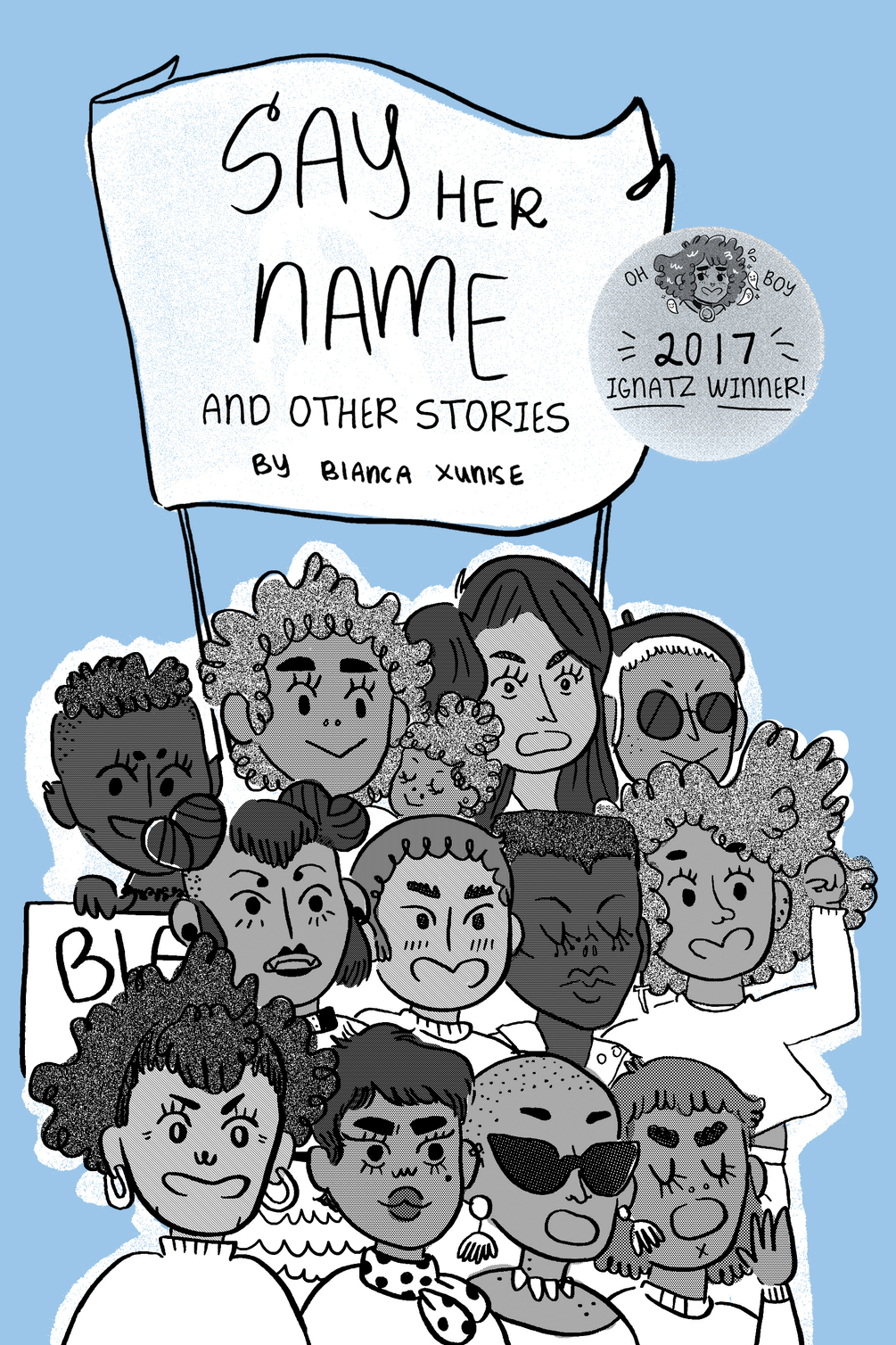I’m kicking off the Black Creator Spotlight with a profile on Bianca Xunise, a Chicago-based artist whom I have followed on Twitter and Instagram for years now. I initially began following her because of her involvement in the Chicago goth scene, and for her punk and goth related jokes, outfits, and musings. In the course of the last few years, I have been treated to her comics as well, many which center around her experiences with racism, sexism, and mental health. Xunise is a cartoonist whose work has appeared in many places including Vogue and The Washington Post, though you may recognize it most readily from The Nib.
A few weeks ago, I finally purchased four of Xunise’s mini-comics through her Gumroad: The Ignatz Award-winning Say Her Name, Rock Against Racism, GothThrob Magazine #1, and The Devil’s Music. Having paid attention to her posts, I knew what to expect and that I would enjoy it. In fact, I hope to one day re-purchase all four, along with more of her other works, in a physical format.
Xunise’s artwork reminds me, favorably, of Charles Schultz’s Peanuts. Her figures have sweet round faces and the easily readable facial expressions that are essential to the cartoon medium. A major important difference is that Xunise’s focus is frequently autobiographical, centering the narrative on the experiences of being a Black woman in the alternative music scene, rather than on a little white boy in Everytown, USA, with only one Black neighbor. Her straightforwardness and willingness to be vulnerable with her audience about her life give her comics the weight of truth.

Say Her Name, a 2017 Ignatz winner, contains several short stories in which Xunise uses anecdotes from her own life to illustrate the larger, systemic issue of racism in America. The first story relates Xunise’s fears for her brothers in the wake of the shootings of young men like Michael Brown, Trayvon Martin, and Philando Castile, as well as her father’s run-in with a police officer who mistook him for another Black man. She discovers that even she, model citizen though she is, is not immune to the judgments of the police. She also details an incident of microaggressions around Halloween, and the time her childhood friend levied a slur at her, effectively ending their friendship.

Xunise learns as a teen that her own mother had a similar experience when she was young, common ground that has likely existed between Black parents and their children for generations. Xunise’s relationship with her mother seems complex, and she touches more on her mother’s parenting style in The Devil’s Music, where she reveals her mother’s preoccupation with her return to the Christian church. This dedication to her religion meant that Xunise’s mother did not allow secular music in the house — unless it was from her own childhood. This seems like an unlikely origin story for a person with so much pop culture knowledge, but it is Xunise’s deep understanding of music history that drew me to her work in the first place.

To that end, I was very drawn to Rock Against Racism, which appealed to my interest in music and history. Somehow, I came in to this mini not knowing much about the Rock Against Racism movement (just a passing reference here and there), and Xunise lays out the basics in a clear, engaging way. She reminds readers that music has always been political, for better or for worse. Beginning with the story of a drunken hate speech from Eric Clapton in 1976, Xunise then launches into the various counterculture music movements that sprung up in the 70s and 80s. I especially appreciate the way she highlights musicians of color who are too frequently overlooked in such overviews of music history. I know that I am guilty of not paying attention to such artists, and Xunise’s brief profiles of artists like Mona Baptiste, Pauline Black, and Steel Pulse (as well as her discussions about them and others on Twitter) have inspired me to dig a little deeper when looking for something to listen to.

After all, music is the main reason I started following Xunise. I was really excited to read GothThrob Magazine #1, which talks about her various gothy loves. Included in this list are Dave Vanian of The Damned (pictured on the zine’s cover), the Mothman, and the Chicago goth scene itself. The tone of this mini is much lighter than the others, a sweet indulgence that moves beyond Xunise’s worries and woes to her joys. She makes a point to talk about two incredible Black woman musicians who helped shape rock music: Sister Rosetta Tharpe (one of the first musicians to play the electric guitar way back in 1945) and the exuberant Poly Styrene, of the punk band X-Ray Spex. Xunise is flexible in her definition of punk music to being more about pushing against the system that solely focused on a style of music, a philosophy which I share and am glad to see touted by an artist I respect so much.
Recently, Xunise hosted a “Comics as Resistance” workshop with The Believer, which you can watch here. If you do watch, I encourage you to support her Patreon. Using comics as a form of protest or resistance highlights Xunise’s background as a person in the alternative scene, conjuring up images of punk zine fests. Though Xunise definitely fits into that category as a punk creator, I would say that in many ways her work bridges a gap, pulling readers into her orbit who might not otherwise have experience in the goth or punk arena with her incredible ability to reach out authentically to her audience. Once again, it is her deep knowledge and openness of heart that keep me coming back for more of her work. I will absolutely be keeping a close eye on her career; I can’t wait to see what she has on the horizon!